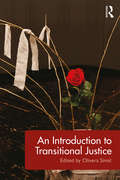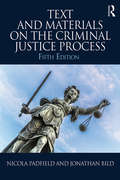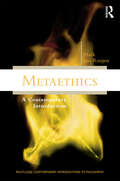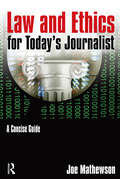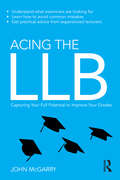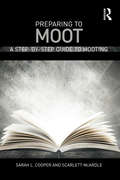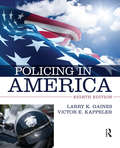- Table View
- List View
Handbook Of Global Economic Governance
by Manuela Moschella Catherine WeaverSince mid-2007, the world scenario has been dominated by the US sub-prime mortgage crisis and its repercussions on global financial markets and economic growth. As banks around the world wrote down their losses and governments intervened to rescue domestic financial institutions, financial distress severely hit the real economy leading to what has been widely defined as the worst recession since the 1930s. Under these conditions, along with the immediate concern for stemming the effects of the crisis, policy-makers around the world have been debating the long-term measures that have to be adopted in order to reduce the likelihood of future crises and to ensure stable economic growth. Although this debate has not yet produced significant transformations, it indicates a renewed concern about the institutional architecture that is meant to govern the global economic and financial system. This book tackles the issue of what the governance of the global economic and financial system looks like and what the prospects for its reform are. Specifically, the book will address the following three main themes: Governance: What is governance in the international economic system? What forms does it take? How did it come about? How can we study it?; Functions of governance: What are the functions of global economic governance? Who performs them? What are the rules and mechanisms that make global governance possible? Problems and prospects of governance: What are the problems in global economic governance? Is there a trade-off between legitimacy and efficiency? What are the prospects for reform of global economic governance in the aftermath of the global financial crisis? This book will: Provide a thorough analysis of the issues at stake in designing international rules and institutions able to govern the global economy; illustrate and analyze virtually all the main institutions, rules, and arrangements that make up global economic governance, inscribing them within the function these institutions, rules, and arrangements are meant to perform; discuss the problems that affect today#65533;s global economic governance and assess alternative proposals to reform the international financial architecture.
An Introduction to Transitional Justice
by Olivera SimicAn Introduction to Transitional Justice provides the first comprehensive overview of transitional justice judicial and non-judicial measures implemented by societies to redress legacies of massive human rights abuse. Written by some of the leading experts in the field it takes a broad, interdisciplinary approach to the subject, addressing the dominant transitional justice mechanisms as well as key themes and challenges faced by scholars and practitioners. Using a wide historic and geographic range of case studies to illustrate key concepts and debates, and featuring discussion questions and suggestions for further reading, this is an essential introduction to the subject for students.
An Introduction to Transitional Justice
by Olivera SimicAn Introduction to Transitional Justice provides the first comprehensive overview of transitional justice judicial and non-judicial measures implemented by societies to redress legacies of massive human rights abuse. Written by some of the leading experts in the field it takes a broad, interdisciplinary approach to the subject, addressing the dominant transitional justice mechanisms as well as key themes and challenges faced by scholars and practitioners. Using a wide historic and geographic range of case studies to illustrate key concepts and debates, and featuring discussion questions and suggestions for further reading, this is an essential introduction to the subject for students.
Text and Materials on the Criminal Justice Process
by Nicola Padfield Jonathan BildHighlighting key issues in Criminal Justice that students need to consider, the Fifth Edition of this popular text contains a wide and varied selection of materials which help to explain the evolution of the criminal justice process in England and Wales since the early 1990s. Statutes, case law, empirical research and official and unofficial reports, as well as theoretical perspectives and academic comment are woven together and contextualized by the accompanying narrative to provide an authoritative account of the recent development of the criminal justice system. Fully updated, this Fifth Edition explores the issues around: • the introduction of Police and Crime Commissioners; • the contracting out of probation services; • the significant reforms to legal aid funding; • the challenges to trial by jury posed by the internet. This book also helpfully directs students to further reading by chapter to provide next steps for research. Written in an accessible style, Text and Materials on the Criminal Justice Process is a valuable resource for students of criminal justice.
A Matter of Interpretation: Federal Courts and the Law
by Antonin Scalia Amy GutmannWe are all familiar with the image of the immensely clever judge who discerns the best rule of common law for the case at hand. According to U.S. Supreme Court Justice Antonin Scalia, a judge like this can maneuver through earlier cases to achieve the desired aim—"distinguishing one prior case on his left, straight-arming another one on his right, high-stepping away from another precedent about to tackle him from the rear, until (bravo!) he reaches the goal—good law." But is this common-law mindset, which is appropriate in its place, suitable also in statutory and constitutional interpretation? In a witty and trenchant essay, Justice Scalia answers this question with a resounding negative.In exploring the neglected art of statutory interpretation, Scalia urges that judges resist the temptation to use legislative intention and legislative history. In his view, it is incompatible with democratic government to allow the meaning of a statute to be determined by what the judges think the lawgivers meant rather than by what the legislature actually promulgated. Eschewing the judicial lawmaking that is the essence of common law, judges should interpret statutes and regulations by focusing on the text itself. Scalia then extends this principle to constitutional law. He proposes that we abandon the notion of an everchanging Constitution and pay attention to the Constitution's original meaning. Although not subscribing to the “strict constructionism” that would prevent applying the Constitution to modern circumstances, Scalia emphatically rejects the idea that judges can properly “smuggle” in new rights or deny old rights by using the Due Process Clause, for instance. In fact, such judicial discretion might lead to the destruction of the Bill of Rights if a majority of the judges ever wished to reach that most undesirable of goals.This essay is followed by four commentaries by Professors Gordon Wood, Laurence Tribe, Mary Ann Glendon, and Ronald Dworkin, who engage Justice Scalia’s ideas about judicial interpretation from varying standpoints. In the spirit of debate, Justice Scalia responds to these critics.Featuring a new foreword that discusses Scalia’s impact, jurisprudence, and legacy, this witty and trenchant exchange illuminates the brilliance of one of the most influential legal minds of our time.
A Matter of Interpretation: Federal Courts and the Law
by Antonin Scalia Amy GutmannWe are all familiar with the image of the immensely clever judge who discerns the best rule of common law for the case at hand. According to U.S. Supreme Court Justice Antonin Scalia, a judge like this can maneuver through earlier cases to achieve the desired aim—"distinguishing one prior case on his left, straight-arming another one on his right, high-stepping away from another precedent about to tackle him from the rear, until (bravo!) he reaches the goal—good law." But is this common-law mindset, which is appropriate in its place, suitable also in statutory and constitutional interpretation? In a witty and trenchant essay, Justice Scalia answers this question with a resounding negative.In exploring the neglected art of statutory interpretation, Scalia urges that judges resist the temptation to use legislative intention and legislative history. In his view, it is incompatible with democratic government to allow the meaning of a statute to be determined by what the judges think the lawgivers meant rather than by what the legislature actually promulgated. Eschewing the judicial lawmaking that is the essence of common law, judges should interpret statutes and regulations by focusing on the text itself. Scalia then extends this principle to constitutional law. He proposes that we abandon the notion of an everchanging Constitution and pay attention to the Constitution's original meaning. Although not subscribing to the “strict constructionism” that would prevent applying the Constitution to modern circumstances, Scalia emphatically rejects the idea that judges can properly “smuggle” in new rights or deny old rights by using the Due Process Clause, for instance. In fact, such judicial discretion might lead to the destruction of the Bill of Rights if a majority of the judges ever wished to reach that most undesirable of goals.This essay is followed by four commentaries by Professors Gordon Wood, Laurence Tribe, Mary Ann Glendon, and Ronald Dworkin, who engage Justice Scalia’s ideas about judicial interpretation from varying standpoints. In the spirit of debate, Justice Scalia responds to these critics.Featuring a new foreword that discusses Scalia’s impact, jurisprudence, and legacy, this witty and trenchant exchange illuminates the brilliance of one of the most influential legal minds of our time.
Bourne on Company Law
by Nicholas BourneAn ideal introductory textbook, Bourne on Company Law offers a succinct overview of the fundamental areas covered in LLB and GDL courses. The text is clear and easy to follow, being presented in short, sub-headed sections for ease of navigation, and is thoroughly cross-referenced to highlight connections across topics. Written for both law and non-law students, this text offers straightforward explanations of all key cases, as well as chapter summaries and end of chapter questions to aid understanding. The book is also supported by a companion website offering self-test questions, a useful glossary and annotated web links.
Tort Law
by Sue HodgeThis textbook covers the Tort Law option of the A-level law syllabus, and provides at the same time an ideal introduction for anybody coming to the subject for the first time. The book covers all A-level syllabuses/specification requirements, and is written by the examiner in Tort Law for one of the major examination boards. It contains extensive case illustration, and a range of examination related questions and activities. There is a special focus on key skills, and on the new synoptic assessment syllabus requirements. This fully updated third edition builds upon the success of the first two editions, containing a new section on human rights and new case information such as Z v UK, Rees, Walters, Fairchild, Tomlinson, Marcic, Transco, National Blood, Mothercare, Douglas v Hello, Campbell v MGN. fully updated third edition coverage of OCR and AQA specifications, endorsed by OCR for use with Tort Law option includes new OCR synoptic assessment source materials (for use in examinations in June 2005) with additional guidance author is a Principal Examiner for one of the major examination boards new cases include Z v UK, Rees, Walters, Fairchild, Tomlinson, Marcic, Transco, National Blood, Mothercare, Douglas v Hello, Campbell v MGN, with expanded discussion of human rights and new health and safety regulations
Tort Law
by Sue HodgeThis textbook covers the Tort Law option of the A-level law syllabus, and provides at the same time an ideal introduction for anybody coming to the subject for the first time. The book covers all A-level syllabuses/specification requirements, and is written by the examiner in Tort Law for one of the major examination boards. It contains extensive case illustration, and a range of examination related questions and activities. There is a special focus on key skills, and on the new synoptic assessment syllabus requirements. This fully updated third edition builds upon the success of the first two editions, containing a new section on human rights and new case information such as Z v UK, Rees, Walters, Fairchild, Tomlinson, Marcic, Transco, National Blood, Mothercare, Douglas v Hello, Campbell v MGN. fully updated third edition coverage of OCR and AQA specifications, endorsed by OCR for use with Tort Law option includes new OCR synoptic assessment source materials (for use in examinations in June 2005) with additional guidance author is a Principal Examiner for one of the major examination boards new cases include Z v UK, Rees, Walters, Fairchild, Tomlinson, Marcic, Transco, National Blood, Mothercare, Douglas v Hello, Campbell v MGN, with expanded discussion of human rights and new health and safety regulations
Construction Contracts: Law and Management
by Will Hughes Ronan Champion John MurdochThe fifth edition of this bestselling textbook has been thoroughly revised to provide the most up-to-date and comprehensive coverage of the legislation, administration and management of construction contracts. It now includes comparisons of working with JCT, NEC3, and FIDIC contracts throughout. Introducing this topic at the core of construction law and management, this book provides students with a one-stop reference on construction contracts. Significant new material covers: procurement tendering developments in dispute settlement commentary on all key legislation, case law and contract amendments In line with new thinking in construction management research, this authoritative guide is essential reading for every construction undergraduate and an extremely useful source of reference for practitioners.
Constitutional & Administrative Law
by Hilaire BarnettThis highly-respected textbook is regularly updated to provide complete coverage of the Public Law syllabus and is accompanied by a range of interactive resources designed to support teaching and learning. Mapped to the common course outline, it equips students with an understanding of the constitution’s past, present and future by analysing and illustrating the political and socio-historical contexts which have shaped the major rules and principles of public law, as well as on-going constitutional reform. The new 10th edition has been revised and updated to reflect recent developments in the law including the Defamation Act 2013, Crime and Courts Act 2013 and the Justice and Security Act 2013 and has been enhanced to meet the needs of students and lecturers working in today’s digital world. In addition to the printed textbook users receive access to an enhanced electronic version. The interactive eTextbook brings the benefits of digital to the text – searching, online, offline and mobile access, interactive exercises and note-sharing are just some of the newly integrated features. Key features of the interactive electronic textbook One-click access to the cases on LexisNexis and the statutes on the government’s legislation archive with almost 1,000 embedded hyperlinks in the text The most-up-date book available with author updates twice a year to key developments in Public law End of chapter interactive exercises which enable students to assess their understanding and progress and diagnose areas of weakness An Interactive timeline that provides instant access to essential context on how the constitution has developed historically and politically to the present day A comprehensive bank of essay questions with outline answers to help students prepare for assessments The ability to make notes and highlight key sections of the text and to share your notes with the class Instructor ResourcesA companion website will help instructors integrate the textbook with their teaching and includes links to further reading for students: Access to articles on constitutional and administrative law from The Student Law Review All of the diagrams from the text, ready to be integrated with your teaching Chapter-by-chapter customisable PowerPoint slides which can be used in seminars or lectures A bank of multiple choice questions which can be customised and adapted for formative assessment Weblinks curated by the author in a read-to-click format Please register to gain access to the Instructor’s eResource on www.RoutledgeInteractive.com Further information about the interactive electronic textbook Author Updates twice a year As the law changes, so does the interactive eTextbook. Updates will go live in the Interactive eTextbook and can be downloaded from the Instructor eResource. Hyperlinked citations embedded in the text Students will have one-click access to the full text of cases on LexisNexis® and to statutes on the government’s legislation archive End of chapter assessments and quizzes Hundreds of interactive multiple-choice exercises to encourage students to test their understanding of the key concepts Anytime, anywhere access Made possible by a partnership between Routledge and VitalSource®, your interactive eTextbook is accessible via VitalSource’s Bookshelf - the most used eTextbook platform in the world. Bookshelf makes digital reading possible online, offline as a download or on mobile devices in native apps as well as browsers. Please see the help section if you encounter any difficulties in pairing devices or accessing your eTextbook on your preferred device. Notes It’s easy to add notes and save them in the cloud, these can be synchronised across devices. Online help is built into Bookshelf®. Notes can be used privately or to share comments on the text with a group. This means comments and notes from lectures or seminars can move from instructor to student, student to instructor and student to student.
Metaethics: A Contemporary Introduction (Routledge Contemporary Introductions to Philosophy)
by Mark van RoojenMetaethics: A Contemporary Introduction provides a solid foundation in metaethics for advanced undergraduates by introducing a series of puzzles that most metaethical theories address. These puzzles involve moral disagreement, reference, moral epistemology, metaphysics, and moral psychology. From there, author Mark van Roojen discusses the many positions in metaethics that people will take in reaction to these puzzles. Van Roojen asks several essential questions of his readers, namely: What is metaethics? Why study it? How does one discuss metaethics, given its inherently controversial nature? Each chapter closes with questions, both for reading comprehension and further discussion, and annotated suggestions for further reading.
Law and Ethics for Today's Journalist: A Concise Guide
by Joe MathewsonLaw and Ethics for Today's Journalist offers aspiring and working journalists the practical understanding of law and ethics they must have to succeed at their craft. Instead of covering every nuance of media law for diverse communications majors, Mathewson focuses exclusively on what's relevant for journalists. Even though media law and media ethics are closely linked together in daily journalistic practice, they are usually covered in separate volumes. Mathewson brings them together in a clear and colourful way that practicing journalists will find more useful. Everything a journalist needs to know about legal protections, limitations, and risks inherent in workaday reporting is illustrated with highlights from major court opinions.Mathewson advises journalists who must often make ethical decisions on the spot with no time for the elaborate, multi-faceted analysis. The book assigns to journalists the hard decisions on ethical questions such as whether to go undercover or otherwise misrepresent themselves in order to get a big story. The ethics chapter precedes the law chapters because ethical standards should underlie a journalist's work at all times. There may be occasions when ethics and law are not parallel, thus calling for the journalist to make a personal judgment. Law and Ethics for Today's Journalist is user-friendly, written in clear, direct, understandable language on issues that really matter to a working journalist. Supplementary reading of the actual court cases is recommended and links to most cases are provided in the text. The text includes a fine (but purposely not exhaustive) bibliography listing important and useful legal cases, including instructive appellate and trial court opinions, state as well as federal.
Law and Ethics for Today's Journalist: A Concise Guide
by Joe MathewsonLaw and Ethics for Today's Journalist offers aspiring and working journalists the practical understanding of law and ethics they must have to succeed at their craft. Instead of covering every nuance of media law for diverse communications majors, Mathewson focuses exclusively on what's relevant for journalists. Even though media law and media ethics are closely linked together in daily journalistic practice, they are usually covered in separate volumes. Mathewson brings them together in a clear and colourful way that practicing journalists will find more useful. Everything a journalist needs to know about legal protections, limitations, and risks inherent in workaday reporting is illustrated with highlights from major court opinions.Mathewson advises journalists who must often make ethical decisions on the spot with no time for the elaborate, multi-faceted analysis. The book assigns to journalists the hard decisions on ethical questions such as whether to go undercover or otherwise misrepresent themselves in order to get a big story. The ethics chapter precedes the law chapters because ethical standards should underlie a journalist's work at all times. There may be occasions when ethics and law are not parallel, thus calling for the journalist to make a personal judgment. Law and Ethics for Today's Journalist is user-friendly, written in clear, direct, understandable language on issues that really matter to a working journalist. Supplementary reading of the actual court cases is recommended and links to most cases are provided in the text. The text includes a fine (but purposely not exhaustive) bibliography listing important and useful legal cases, including instructive appellate and trial court opinions, state as well as federal.
Succession, Wills and Probate
by Caroline Sawyer Miriam SperoSuccession, Wills and Probate is an ideal textbook for those taking an undergraduate course in this surprisingly vibrant subject, and also provides a clear and comprehensive introduction for professionals. Against an account of the main social and political themes of succession law, the book gives detailed explanations of core topics such as alternatives to wills and the making, altering and revocation of wills. It also explains personal representatives and how they should deal with a deceased person's estate and interpret and implement the will. Gifts may fail, estates may be insolvent or a person may die intestate, without a will at all. Increasingly relatives and others seek to challenge the will, for example on the grounds of the testator's capacity or under the law of family provision. This third edition is edited, updated and revised to take account of new legislation and case law across all the relevant issues, including a new final chapter dealing with the potentially contentious issues that are becoming more central to professional work in the field of succession.
Succession, Wills and Probate (PDF)
by Caroline Sawyer Miriam SperoSuccession, Wills and Probate is an ideal textbook for those taking an undergraduate course in this surprisingly vibrant subject, and also provides a clear and comprehensive introduction for professionals. Against an account of the main social and political themes of succession law, the book gives detailed explanations of core topics such as alternatives to wills and the making, altering and revocation of wills. It also explains personal representatives and how they should deal with a deceased person's estate and interpret and implement the will. Gifts may fail, estates may be insolvent or a person may die intestate, without a will at all. Increasingly relatives and others seek to challenge the will, for example on the grounds of the testator's capacity or under the law of family provision. This third edition is edited, updated and revised to take account of new legislation and case law across all the relevant issues, including a new final chapter dealing with the potentially contentious issues that are becoming more central to professional work in the field of succession.
European Banking and Financial Law
by Matthias Haentjens Pierre de Gioia-CarabelleseIn recent decades, the volume of EU legislation on financial law has increased exponentially. Banks, insurers, pension funds, investment firms and other financial institutions all are increasingly subject to European regulatory rules, as are day to day financial transactions. Serving as a comprehensive and authoritative introduction to European banking and? financial law, the book is organized around the three economic themes that are central to the financial industry: (i) financial markets; (ii) financial institutions; and (iii) financial transactions. It covers not only regulatory law, but also commercial law that is relevant for the most important financial transactions. It also explains the most important international standard contracts such as LMA loan contracts and the GMRA repurchase agreements. Covering a broad range of aspects of financial law from a European perspective, it is essential reading for students of financial law and European regulation.
European Banking and Financial Law
by Matthias Haentjens Pierre de Gioia-CarabelleseIn recent decades, the volume of EU legislation on financial law has increased exponentially. Banks, insurers, pension funds, investment firms and other financial institutions all are increasingly subject to European regulatory rules, as are day to day financial transactions. Serving as a comprehensive and authoritative introduction to European banking and? financial law, the book is organized around the three economic themes that are central to the financial industry: (i) financial markets; (ii) financial institutions; and (iii) financial transactions. It covers not only regulatory law, but also commercial law that is relevant for the most important financial transactions. It also explains the most important international standard contracts such as LMA loan contracts and the GMRA repurchase agreements. Covering a broad range of aspects of financial law from a European perspective, it is essential reading for students of financial law and European regulation.
Acing the LLB: Capturing Your Full Potential to Improve Your Grades
by John McGarryOften law students don't achieve the results they are capable of, not because of a lack of intellectual ability, but because they haven’t fully understood what is required of them and what they could and should do to achieve higher marks. Acing the LLB will help those students realise their full potential and achieve the very best marks. It explains what lecturers are looking for in a top class answer and is packed with easy-to-follow practical advice that students can use to improve their performance. The author draws upon his own experiences as a lecturer and marker of student work as well as those of colleagues at a range of institutions to offer sound and realistic advice. Engaging, accessible and very readable, this is an ideal guide for anyone starting out on an LLB or for current law students who are looking to improve their grades.
Preparing to Moot: A Step-by-Step Guide to Mooting
by Sarah L. Cooper Scarlett McArdleMooting is an increasingly important activity in UK law schools. This is because mooting offers students the opportunity to develop advanced analytical, research, drafting and advocacy based skills, which help to improve their general academic achievement and employability profiles. Tangible evidence of these skills is invaluable in a progressively competitive job market. The ideal guide for the first-time mooter, Preparing to Moot provides an accessible, systematic and pragmatic approach which demystifies the process. It focuses on analysis, research and argument construction as the foundations for successful advocacy and provides students with a working guide to use alongside moot problems in five popular topic areas: criminal law, contract law, tort law, human rights and the law of equity. Through careful use of annotated examples generated by real students, and expert tips and advice from the authors, the book shows students how to individually analyse, research and construct arguments for various advocate positions, providing a practical and easy-to-follow overview of how to tackle a moot from analysing a problem initially, right up to beginning to advocate.
Professional Misconduct against Juveniles in Correctional Treatment Settings
by Lee Michael JohnsonA significant barrier to successful juvenile intervention is misconduct committed against juveniles by the persons employed to help them. Professional Misconduct with Juveniles explores the nature of employee-on-youth misconduct, its extent, its consequences, factors that increase its occurrence, and potential solutions to the problem. Obviously, employee-on-youth misconduct interferes with the effective treatment of delinquent and at-risk youth, but it also harms the agency as a whole and creates a poor working environment for all employees. Professional Misconduct with Juveniles offers a practical, theory-based approach to preventing or stopping such exploitation of vulnerable young men and women so that we can focus on effective approaches to rehabilitation, deterrence, and public safety.
Professional Misconduct against Juveniles in Correctional Treatment Settings
by Lee Michael JohnsonA significant barrier to successful juvenile intervention is misconduct committed against juveniles by the persons employed to help them. Professional Misconduct with Juveniles explores the nature of employee-on-youth misconduct, its extent, its consequences, factors that increase its occurrence, and potential solutions to the problem. Obviously, employee-on-youth misconduct interferes with the effective treatment of delinquent and at-risk youth, but it also harms the agency as a whole and creates a poor working environment for all employees. Professional Misconduct with Juveniles offers a practical, theory-based approach to preventing or stopping such exploitation of vulnerable young men and women so that we can focus on effective approaches to rehabilitation, deterrence, and public safety.
Postmortem Fingerprinting and Unidentified Human Remains
by Marzena MulawkaFingerprint identification is the most efficient, rapid, and cost-effective forensic identification modality. Postmortem Fingerprinting and Unidentified Human Remains is a consolidated and thorough guide to the recovery, identification, and management of unidentified postmortem fingerprint records - topics from postmortem fingerprint processing to database submission and case management are discussed. Additionally, a postmortem processing workflow is described, which delineates various basic and advanced fingerprint recovery techniques used to acquire examination-quality records. Furthermore, Postmortem Fingerprinting and Unidentified Human Remains discusses the complexity of antemortem fingerprint databases and how to access each database for humanitarian purposes, bringing a modern value perspective to the topic.
Postmortem Fingerprinting and Unidentified Human Remains
by Marzena MulawkaFingerprint identification is the most efficient, rapid, and cost-effective forensic identification modality. Postmortem Fingerprinting and Unidentified Human Remains is a consolidated and thorough guide to the recovery, identification, and management of unidentified postmortem fingerprint records - topics from postmortem fingerprint processing to database submission and case management are discussed. Additionally, a postmortem processing workflow is described, which delineates various basic and advanced fingerprint recovery techniques used to acquire examination-quality records. Furthermore, Postmortem Fingerprinting and Unidentified Human Remains discusses the complexity of antemortem fingerprint databases and how to access each database for humanitarian purposes, bringing a modern value perspective to the topic.
Policing in America
by Larry K. Gaines Victor E. KappelerIn the field of law enforcement in the United States, it is essential to know the contemporary problems being faced and combine that knowledge with empirical research and theoretical reasoning to arrive at best practices and an understanding of policing. Policing in America, Eighth Edition, provides a thorough analysis of the key issues in policing today, and offers an issues-oriented discussion focusing on critical concerns such as personnel systems, organization and management, operations, discretion, use of force, culture and behavior, ethics and deviance, civil liability, and police-community relations. A critical assessment of police history and the role politics played in the development of American police institutions is also addressed, as well as globalization, terrorism, and homeland security. This new edition not only offers updated research and examples, it also incorporates more ways for the reader to connect to the content through learning objectives, discussion questions, and "Myths and Realities of Policing" boxes. Video and Internet links provide additional coverage of important issues. With completely revised and updated chapters, Policing in America, Eighth Edition provides an up-to-date examination of what to expect as a police officer in America.

